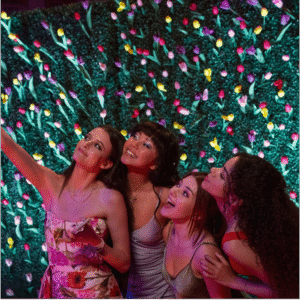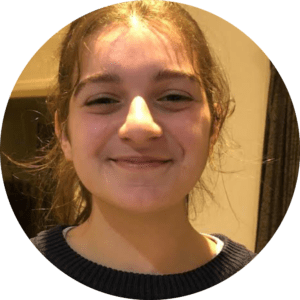16-year-old Noa Gomberg reviews the third season and explores its complex characters and relationship dynamics

Ginny (far right), played by Antonia Gentry, and friends in season 3 of ‘Ginny & Georgia’.
Picture by: Amanda Matlovich | Netflix | Alamy
Article link copied.
July 24, 2025
Ginny & Georgia, season 3: Is it as good as the hype?

The highly awaited third season of the very popular young adult Netflix drama Ginny & Georgia was recently released and – oh my God.
From truly shocking plot twists to the pains of growing up, this series has it all. It’s no wonder I got through all ten episodes (which are about one hour each) in a single sitting. And I know this season will be added to my rewatch list.
If you haven’t watched Ginny & Georgia before, beware! This article contains spoilers, especially from the third season.
Trigger warning: self-harm, eating disorders, addiction.
Harbingers’ Weekly Brief
The show explores the complex relationship between 16-year-old Ginny Miller and her 31-year-old mother, Georgia, as they navigate a fresh start in the fictional town of Wellsbury, US. In this third season, Georgia is on trial for murder and Ginny, and those around her, try to grapple with the challenges that arise from the trial while coping with personal problems.
What really stood out is how the writers create such real, messy, imperfect relationships and characters. As a reflection of what it means to be a teenager, several types of interpersonal relationships are depicted such as familial, romantic and platonic.
To me, the family dynamic that stands out is between the 16-year-old twins, Marcus (Ginny’s boyfriend) and his bubbly and intense sister Max. Introverted and very kind, Marcus struggles with severe depression and an alcohol addiction due to his best friend’s death the year before. His sister urges him to talk to their parents and seek help. He threatens to never speak to her again if she tells anyone about his problem.
The writers masterfully convey the tension between the pain of seeing your sibling – the person who knows you better than anyone – struggle and not wanting to destroy your relationship with them.
As for romantic relationships, there was a surprising development this season. After a series of toxic relationships, Abby (a friend of Ginny’s) realises she is queer and starts dating Tris, who is non-binary. What I find so beautiful about this relationship is that Abby states she does not want her sexuality to eclipse the rest of her identity. She simply wants to like and date someone, without it being a big deal.
It sets a great example of how natural queer identities are, which is particularly powerful to teenage audiences.
The show also touches on racial identity. Wellsbury is a predominantly white town, which often makes Ginny – who is biracial – feel displaced, especially after enduring several microaggressions. That is, until she becomes great friends with Bracia, who is Black. Bracia stands by Ginny’s side through the whole ordeal of Georgia’s trial, protecting her from all the stares Ginny is subjected to at school. Also, Bracia is able to understand a part of Ginny’s identity that is often not thought about by others, providing Ginny with a safe place to be truly and wholly herself.
The show also touches on other sensitive topics relevant to young people around the world.
In particular, it should be commended for helping to break the stigma around mental health, self-harm and asking for help.
Ginny self-harms. Georgia finds out about it and learns to be respectful towards that topic and even helps Ginny when she has the urge to relapse.
In this season, Ginny gradually tells more people, including her friends, about her struggle. She quotes her therapist in saying that “secrets hold power”, and the more people know about the secret, the less shame and anguish it generates.
Another character that struggles with their mental health is Abby, who has bulimia. After hiding her eating disorder in previous seasons, she is able to tell Ginny and another friend Nora about it. When the season ends, she is yet to seek help, but this was masterfully done. The show depicts people at different stages of their mental health journey, showing that recovery is not linear, but it is possible.
The only issue I had with Ginny & Georgia is the age of the actors. For example, Ginny and Marcus are 16 in the show, but the actors who play them – Antonia Gentry and Felix Mallard – are both 27.
This can be harmful to the actual teenagers watching the show, because it can create unrealistic expectations as to how we’re supposed to look. Real teenagers have acne and braces, not perfect skin and straight teeth.
I do understand why teenage actors could not be hired for this series – especially given the sex scenes between them. However, I believe shows should endeavour to make their work appropriate for teenage actors to ensure authenticity in the roles.
This show is a must-watch if you love complex characters, messy relationships and of course, a good murder trial.
Written by:

The Harbinger Prize 2024 (Women’s Desk)
Writer
Melbourne, Australia
Noa was born in 2008 in Rio de Janeiro, Brazil, and moved to Australia at the age of nine, where she currently studies. She is passionate about books, history, science, fiction and poetry writing, and social media, with plans to study Politics and Law in the future.
She joined Harbingers’ Magazine in 2024 after winning the Women’s Desk category of the Harbingers’ Prize, writing about current affairs, history, and pop culture. After successfully completing the Essential Journalism course, Noa became a writer for the magazine starting in March 2025.
In her free time, she enjoys writing short stories, poems, and arguing over dinner.
Noa speaks Portuguese and English.
Edited by:

🌍 Join the World's Youngest Newsroom—Create a Free Account
Sign up to save your favourite articles, get personalised recommendations, and stay informed about stories that Gen Z worldwide actually care about. Plus, subscribe to our newsletter for the latest stories delivered straight to your inbox. 📲
© 2025 The Oxford School for the Future of Journalism


